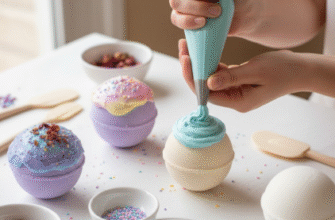Have you ever scanned the ingredients list on your store-bought face wash and felt a little overwhelmed? Sometimes, simpler is better, especially when it comes to what we put on our skin. Creating your own gentle foaming face wash is surprisingly easy, rewarding, and allows you complete control over the ingredients. Forget harsh sulfates and mysterious chemicals; let’s dive into crafting a cleanser that leaves your skin feeling soft, clean, and happy, using ingredients you can actually pronounce.
Making your own skincare products might sound intimidating, but a foaming face wash is one of the simplest places to start. It doesn’t require complex chemistry, just a few key ingredients and the right kind of bottle. The result is a light, airy foam that cleanses effectively without stripping your skin’s natural moisture barrier – something many commercial cleansers are guilty of.
Why Bother Making Your Own Face Wash?
The reasons for going DIY are plentiful. Firstly, ingredient transparency is a huge plus. You know exactly what’s in your cleanser because you put it there yourself. This is particularly beneficial if you have sensitive skin or allergies and need to avoid specific irritants commonly found in mass-produced products, like synthetic fragrances, harsh detergents (like SLS or SLES), parabens, or artificial colors.
Secondly, it’s often more cost-effective in the long run. While there’s an initial small investment in base ingredients, they typically last through many batches, making each bottle significantly cheaper than buying a pre-made foaming cleanser. Think about it: a large bottle of castile soap or glycerin can be used for numerous DIY projects beyond just face wash.
Thirdly, customization is key. Your skin isn’t exactly the same as anyone else’s, so why should your cleanser be generic? With a DIY recipe, you can tweak the ingredients to better suit your preferences. Want a more hydrating feel? Add a touch more glycerin. Prefer a certain scent? Incorporate a skin-safe essential oil you love (with proper dilution, of course). You become the formulator for your own unique needs.
Lastly, there’s the satisfaction and fun factor. There’s something genuinely rewarding about using a product you created with your own hands. It connects you more closely to your self-care routine and reduces reliance on store-bought items, which can also be a step towards a more sustainable lifestyle by reducing packaging waste if you reuse your foaming pump bottle.
Understanding the Building Blocks
A good foaming face wash relies on a few core components working together. Understanding their roles helps you appreciate the simplicity and effectiveness of the recipe.
The Liquid Base
This makes up the bulk of your cleanser. The best choice here is distilled or purified water. Why? Tap water contains minerals and potential impurities that can affect the cleanser’s stability and potentially irritate the skin or leave residue. Using distilled water ensures a clean, pure base and helps prolong the (admittedly short) shelf life of a preservative-free product. Alternatively, you could use floral waters, also known as hydrosols (like rosewater or chamomile water), for added subtle scent and potential soothing properties. Ensure they are pure hydrosols without added alcohol or preservatives if possible.
The Cleansing Agent
We need something to actually lift away dirt and oil. For a gentle foaming wash, liquid castile soap is the star. This vegetable oil-based soap (traditionally olive oil, but now often coconut, hemp, or jojoba oil based) is biodegradable and much gentler than synthetic detergents. It cleans effectively without being overly harsh. Look for unscented varieties to avoid potential irritation from added fragrances, allowing you to control the scent yourself if desired.
Moisturizing & Soothing Agents
To counteract any potential drying effect of the soap (even gentle soap can be slightly drying for some) and add beneficial properties, we include humectants and emollients.
- Vegetable Glycerin: This is a humectant, meaning it draws moisture from the air to your skin, helping to keep it hydrated. It also contributes to a smoother feel.
- Aloe Vera Gel: Known for its soothing and hydrating properties, pure aloe vera gel (look for ones with minimal additives) can be a wonderful addition, especially if your skin feels easily irritated.
- Carrier Oils (Optional and Use Sparingly): A tiny amount of a light, non-comedogenic carrier oil like jojoba oil or sweet almond oil can add extra moisturizing properties. However, use this with caution – too much oil can prevent the mixture from foaming properly and might not suit oily or acne-prone skin. Often, glycerin and aloe are sufficient.
Optional Enhancements: Essential Oils
A few drops of skin-safe essential oils can add a pleasant aroma and potentially some subtle skin benefits. Good options include lavender (calming scent), chamomile (gentle), or tea tree (use very diluted, known for clarifying properties, but can be potent). Crucially, essential oils must be used in very small amounts (literally just a few drops per batch) and should be patch-tested, as they can cause irritation or allergic reactions in some individuals. If you have sensitive skin, it’s often best to skip them entirely. Avoid phototoxic oils like bergamot or lemon if you’ll be out in the sun.
The Magic: The Foaming Pump Bottle
This isn’t an ingredient, but it’s essential! You cannot get foam without a specific foaming soap dispenser bottle. These bottles have a special pump mechanism that injects air into the liquid soap solution as it dispenses, creating that lovely light foam. You can buy these online or sometimes find them in stores. Make sure to clean it thoroughly between batches.
Crafting Your Gentle Foaming Face Wash: The Recipe
Ready to mix? This basic recipe is a great starting point. Remember to work with clean hands and equipment.
Ingredients:
- 1/3 cup Distilled Water (or pure hydrosol like rosewater)
- 1/3 cup Liquid Castile Soap (unscented recommended)
- 1 teaspoon Vegetable Glycerin
- 1 teaspoon Aloe Vera Gel (optional, ensure it’s pure)
- 1/4 teaspoon Carrier Oil like Jojoba or Sweet Almond Oil (optional, start with less or omit if unsure)
- 2-5 drops Skin-Safe Essential Oil like Lavender or Chamomile (optional and strictly for scent/mild properties, patch test first!)
- A clean, empty Foaming Pump Bottle (approx. 200-250ml or 8 oz capacity is ideal for these amounts)
Instructions:
- Prepare the Bottle: Ensure your foaming pump bottle is clean and dry.
- Combine Liquids (Gently): Carefully pour the distilled water (or hydrosol) into the bottle first. Then add the liquid castile soap. Try not to shake it vigorously at this stage, or you’ll create excessive bubbles inside the bottle before you even get to the pump.
- Add Moisturizers: Add the vegetable glycerin and aloe vera gel (if using).
- Add Optional Ingredients: If using, add the small amount of carrier oil and the few drops of essential oil.
- Secure the Pump: Place the foaming pump lid securely onto the bottle.
- Mix Gently: Swirl the bottle gently to combine the ingredients. Avoid vigorous shaking, which can create too much foam inside the bottle and affect the pump mechanism over time. Gentle tilting and swirling are usually sufficient.
- Label and Date: It’s wise to label your creation with the contents and the date it was made.
Important Safety Notes: Always perform a patch test on a small, inconspicuous area of your skin (like the inside of your wrist or elbow) 24 hours before using your new homemade face wash extensively. This helps check for any potential irritation or allergic reactions. Ensure all your tools, measuring spoons, and the foaming bottle are thoroughly cleaned before you start to minimize bacterial contamination and preserve the integrity of your wash.
Making It Your Own: Customization Ideas
The beauty of DIY is adaptability. Feel free to adjust the basic recipe once you know how your skin responds:
- Hydration Boost: If your skin feels a little tight after washing, try increasing the glycerin slightly (e.g., up to 1.5 or 2 teaspoons).
- Soothing Variations: Use chamomile or calendula hydrosol as your base water for potentially enhanced calming effects.
- Scent Exploration: Experiment with different skin-safe essential oil combinations (always diluted!). A drop of geranium and a drop of lavender can offer a floral note. Remember, less is more.
- Oil Adjustment: If you included carrier oil and found it too heavy, simply omit it next time. If your skin is very dry and tolerated the oil well, you could *cautiously* increase it slightly, but be mindful it can impact foaming.
How to Use Your Homemade Cleanser
Using your DIY foaming wash is straightforward:
- Wet your face with lukewarm water.
- Pump 1-2 pumps of the foam into your clean hands.
- Gently massage the foam onto your face in circular motions, avoiding the eye area.
- Rinse thoroughly with lukewarm water.
- Pat your skin dry gently with a clean towel.
- Follow up with your usual toner, serum, or moisturizer.
The foam is light, so you might find you enjoy washing for a slightly longer time than with a gel or cream cleanser. Enjoy the process!
Storage and Keeping it Fresh
Because this recipe contains water and lacks strong preservatives, it won’t last as long as commercial products.
- Storage: Keep the bottle in a cool, relatively dark place (like a bathroom cabinet). Avoid direct sunlight.
- Shelf Life: Aim to use your batch within 2-4 weeks for optimal freshness and safety. Using distilled water and clean equipment helps maximize this timeframe.
- Signs of Spoilage: Discard the wash immediately if you notice any change in smell (e.g., sour, moldy), color, or consistency, or if you see any visible mold growth. When in doubt, throw it out and make a fresh batch – it’s quick and inexpensive!
Final Thoughts on Your Foaming Creation
Creating your own gentle foaming face wash is an empowering step towards a more natural and personalized skincare routine. It demystifies product formulations and puts you in charge of what touches your skin. You get a fresh, effective cleanser free from harsh chemicals, tailored (by you!) to your liking, often at a fraction of the cost of store-bought alternatives.
Remember to start with the basic recipe, patch test, and then feel free to experiment cautiously with the optional ingredients once you’re comfortable. Enjoy the light, airy texture and the satisfaction of knowing exactly what you’re using to cleanse your face. Happy mixing!








